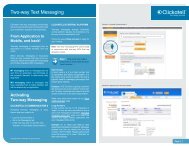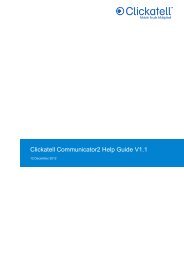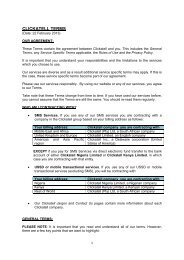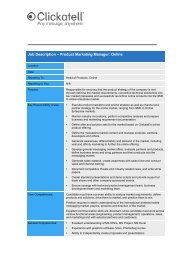Com API Specification V2.3.4 - Clickatell
Com API Specification V2.3.4 - Clickatell
Com API Specification V2.3.4 - Clickatell
Create successful ePaper yourself
Turn your PDF publications into a flip-book with our unique Google optimized e-Paper software.
<strong>Com</strong> <strong>API</strong> <strong>Specification</strong> V2.3.5<br />
September 2014
v. 2.3.5<br />
Content<br />
1. Change history ...................................................................................................................................... 3<br />
2. Overview ............................................................................................................................................... 3<br />
3. Introduction ........................................................................................................................................... 4<br />
4. Getting started ...................................................................................................................................... 5<br />
5. Basic methods ...................................................................................................................................... 6<br />
5.1. Authentication and session IDs ........................................................................................................ 6<br />
5.2. Ping................................................................................................................................................... 6<br />
5.3. Send message .................................................................................................................................. 6<br />
5.4. Send simple SMS message ............................................................................................................. 6<br />
5.5. Query message ................................................................................................................................ 7<br />
6. Published properties ............................................................................................................................. 8<br />
7. Additional methods ............................................................................................................................. 10<br />
7.1. Delete/Stop message ..................................................................................................................... 10<br />
7.2. Query balance ................................................................................................................................ 11<br />
7.3. Coverage query .............................................................................................................................. 11<br />
7.4. Get message charge query ............................................................................................................ 11<br />
7.5. Token pay ....................................................................................................................................... 11<br />
Send an Over-The-Air configuration as XML ............................................................................................ 11<br />
7.6. Send an internet bookmark Over-The-Air ...................................................................................... 12<br />
7.7. Send settings Over-The-Air ............................................................................................................ 12<br />
7.8. Reset the COM object .................................................................................................................... 13<br />
7.9. Determining the com object version number .................................................................................. 13<br />
7.10. Encode to Unicode ..................................................................................................................... 13<br />
8. Batch messaging ................................................................................................................................ 14<br />
8.1. Start batch ...................................................................................................................................... 14<br />
8.2. Send messages to existing batch ................................................................................................... 14<br />
8.3. Quick send to batch ........................................................................................................................ 14<br />
8.4. End batch ....................................................................................................................................... 14<br />
9. 8-Bit messaging .................................................................................................................................. 15<br />
10. Configuring internet connection ...................................................................................................... 15<br />
10.1. Configuring the proxy settings only ............................................................................................ 15<br />
10.2. Configuring the proxy settings including testing ........................................................................ 16<br />
Setting the connection time-out value ....................................................................................................... 16<br />
10.3. Setting receive timeout value ..................................................................................................... 17<br />
11. Enums and their values .................................................................................................................. 17<br />
11.1. Message types (eSMSMsgType) ............................................................................................... 17<br />
11.2. Concatentation (eSMSConcatType) .......................................................................................... 17<br />
11.3. Callback type (eSMSCallbackType) .......................................................................................... 17<br />
11.4. Callback System ........................................................................................................................ 18<br />
11.5. <strong>Com</strong>munication type (eSMS<strong>Com</strong>municationType) .................................................................... 19<br />
11.6. Message ID type (eSMS<strong>API</strong> or CLI_ID) ..................................................................................... 19<br />
11.7. eSMSInetConnection ................................................................................................................. 19<br />
11.8. Delivery queue (eSMSSendQueue)........................................................................................... 19<br />
11.9. Gateway escalation (eSMSEscalate)......................................................................................... 19<br />
11.10. Required features (eSMSReqFeatures) .................................................................................... 19<br />
11.11. Send Over-The-Air ..................................................................................................................... 20<br />
12. Message examples ......................................................................................................................... 22<br />
13. Appendix A: Error codes................................................................................................................. 26<br />
14. Appendix B: Message statuses (eSMSMsgStatus)........................................................................ 28<br />
15. Terminology .................................................................................................................................... 29<br />
16. Contact details ................................................................................................................................ 29<br />
www.clickatell.com<br />
2
v. 2.3.5<br />
1. Change history<br />
Approximately six (6) months of changes are reflected.<br />
Visit http://www.clickatell.com/downloads/com/<strong>Clickatell</strong>_COM.pdf to check for updates to this document.<br />
Version Date Section Changes to Documentation<br />
2.3.5 General document review and update.<br />
2.3.4 08 April 2013 Updated document branding and menu items for Central<br />
Reload.<br />
2. Overview<br />
This technical document is intended for developers who wish to build applications that make use of the<br />
<strong>Clickatell</strong> COM <strong>API</strong> for sending messages. It describes the various programming methods and commands<br />
used by developers when using this <strong>API</strong>. The COM <strong>API</strong> provides a set of methods and definitions for<br />
integration into applications or .asp pages and is most suitable for the development and deployment of<br />
desktop applications.<br />
To use this <strong>API</strong>, you need to register at (http://www.clickatell.com/register/product=1). When you sign up<br />
for an account, you will be given a username, password and api_id: keep these at hand. A .zip file with the<br />
COM Installer is available. Once you have registered and been activated, you will receive 10 free credits<br />
with which to test our service. Messages sent with these credits contain a pre-populated <strong>Clickatell</strong><br />
message. You can test the <strong>API</strong> using these credits, and purchase credits to start sending your own,<br />
customised messages.<br />
It is recommended that you have an understanding of routing profiles before reading this document.<br />
Information is available at https://www.clickatell.com/resources/product-help/developers-central/routingprofile-guide/.<br />
There are a number of different ways of gaining access to the gateway:<br />
• SMTP - enabling a server or client generated email to be delivered as an SMS.<br />
• HTTP / HTTPS - submitting either a POST or GET to the <strong>API</strong> server.<br />
• FTP – uploading a text file to our FTP Server.<br />
• XML – posting to our gateway using XML over HTTP/S.<br />
• COM Object – for Windows based development.<br />
• SOAP – submit SOAP packets over HTTP/S.<br />
• SMPP – customers requiring a high throughput binary socket connection.<br />
Testing the <strong>Clickatell</strong> Gateway<br />
<strong>Clickatell</strong> offers a test number range which will assist in reducing testing costs. Messages sent to any<br />
number on this prefix will only be charged 1/3 of a credit. When testing the <strong>Clickatell</strong> gateway you can use<br />
the number 279991xxxxx (for South Africa) or 1999xxxxxxx (for the U.S.) where “xxxxx” represents any<br />
numeric string. The status of your messages will be returned.<br />
We will cover the COM Object method in this document. Additional documentation is available for the<br />
other methods.<br />
www.clickatell.com<br />
3
v. 2.3.5<br />
3. Introduction<br />
The <strong>Clickatell</strong> HTTP specification describes how a user can interact with the <strong>Clickatell</strong> SMS Gateway via<br />
the HTTP or HTTPS communication protocols. Since not everybody is able or willing to implement the<br />
whole HTTP/S channel, we have made a COM Object available that takes the hassle out of this process.<br />
The COM-<strong>API</strong> Object exports a rich set of methods and definitions that will make it easy for a user to<br />
integrate SMS sending into their programs or web pages. Various sections of this document will show you<br />
how to send SMSs in Visual Basic, both in early and late binding mode, and in VBScript (essentially late<br />
bound Visual Basic). Since the COM Object interface is completely documented, any COM-enabled<br />
programming language or framework such as .NET can be used.<br />
The COM Object is defined by the following class name: SMS_COM<strong>API</strong>.SMS<br />
The COM Object supports all interfaces described by the HTTP <strong>API</strong> specification with the exception of<br />
WAP and MMS push. It also provides properties for all parameters defined in the HTTP <strong>API</strong> specification.<br />
It is important that parameter lengths and allowed characters, as defined in the HTTP <strong>API</strong> <strong>Specification</strong>s,<br />
are followed.<br />
When using the COM Object with early binding, e.g. referencing the SMS_COM<strong>API</strong> type library in VB, a<br />
range of predefined constants is also available. When using late binding the SDK supplies the SMS_COM<br />
<strong>API</strong>.bas file with the required constant definitions.<br />
Important: Many of the parameters and methods defined in this document have more detailed<br />
descriptions, which are found in the HTTP <strong>API</strong> Technical <strong>Specification</strong> document:<br />
http://www.clickatell.com/downloads/http/<strong>Clickatell</strong>_HTTP.pdf<br />
Security<br />
Since the Internet is an open communication medium, security might be an issue. If you do not want<br />
anybody to intercept your SMS messages as they are being sent to <strong>Clickatell</strong>, we offer you the means to<br />
send your SMS encrypted. The secure communication channel is established via a SSL (Secure Socket<br />
Layer) channel.<br />
The actual communication between the COM Object and <strong>Clickatell</strong> is transparent to your programming, so<br />
your code does not have to change. We have provided the sms<strong>Com</strong>municationType method to allow you<br />
select encrypted or non-encrypted SMS submittal.<br />
The COM Object does not need to have the SSL libraries installed in order to send SMS. The<br />
CanSendViaSSL property indicates if the SSL libraries are loaded or not.<br />
Calling the method with the SMS_COMMS_SSL parameter, switches the COM Object into encrypted<br />
communication mode. SMS_COMMS_HTTP is the default (non-encrypted) way of submitting your SMS.<br />
www.clickatell.com<br />
4
v. 2.3.5<br />
4. Getting started<br />
In order to use the <strong>Clickatell</strong> gateway you need a <strong>Clickatell</strong> account and at least one registered connection<br />
(<strong>API</strong> sub-product instance) between your application and our gateway. Each connection method is known<br />
as a sub-product (of our <strong>API</strong> product). You can follow these steps to get started:<br />
Step 1 - register for a <strong>Clickatell</strong> account<br />
If you do not already have a Developers’ Central account, you need to register for one. If you already have<br />
a <strong>Clickatell</strong> Central account, proceed to Step 2 for instructions on how to edit an <strong>API</strong> connection on your<br />
account.<br />
• Go to https://www.clickatell.com/clickatell-products/online-products/sms-gateway-developers-central/,<br />
and click on the ‘Try Developers’ Central Now’ button.<br />
• Select the Developers’ Central and the Account type you would like to use.<br />
• Enter your personal information to complete the registration form<br />
• Accept Terms & Conditions<br />
• Click the ‘Create my Account’ button - an email containing your login details will be sent to the email<br />
address you have provided.<br />
Step 2 – Login to your account<br />
When you have logged in you will be on the <strong>Clickatell</strong> Central landing page. You will receive 10 free<br />
credits which you can use to test the <strong>Clickatell</strong> Gateway. Please note that for security reasons these 10<br />
credits contain pre-set <strong>Clickatell</strong> content.<br />
A HTTP <strong>API</strong> will be added to your account for you. This will allow you to start testing the <strong>Clickatell</strong><br />
Gateway immediately. You can purchase credits when you are ready to start sending personalised<br />
messages.<br />
Step 3 – Adding a COM <strong>API</strong> to your account<br />
To add a COM <strong>API</strong> to your account select <strong>API</strong>s from the main menu and then select Setup a new <strong>API</strong><br />
from the submenu. Click the Add COM <strong>API</strong> button on the Setup <strong>API</strong> page that opens. You can then<br />
complete all the required details to configure your <strong>API</strong>.<br />
After successfully adding a connection, a confirmation message will be displayed with a unique <strong>API</strong> ID<br />
and information on how to get started.<br />
The getting started section displays the <strong>API</strong> connection parameters and authentication details. These<br />
details are required when connecting to the <strong>Clickatell</strong> gateway to send a message.<br />
Note: For more information on managing your <strong>API</strong> connections within your <strong>Clickatell</strong> account see our <strong>API</strong><br />
guide at http://www.clickatell.com/help-support/developer-apis/clickatell-api/<br />
www.clickatell.com<br />
5
v. 2.3.5<br />
5. Basic methods<br />
The following sections describe each of the methods published by the COM Object. Every section gives<br />
details about the method name, the input parameters list and return values.<br />
5.1. Authentication and session IDs<br />
Name:<br />
Desc:<br />
Authenticate<br />
Used to authenticate. A Session ID is returned, which must be used with all future<br />
transactions<br />
Parameters: String <strong>API</strong>_ID<br />
String Username<br />
String Password<br />
Boolean Encode [True]<br />
Returns:<br />
5.2. Ping<br />
OK: session_id<br />
or<br />
ERR: Error number<br />
Name:<br />
Desc:<br />
Parameters:<br />
Returns:<br />
Ping<br />
This will prevent a Session ID from expiring in periods of inactivity. The Session ID<br />
is set to expire after 15 minutes of inactivity.<br />
OK<br />
or<br />
ERR: Error number<br />
5.3. Send message<br />
Name:<br />
Desc:<br />
SendMsg<br />
This method will send an SMS message.<br />
Parameters: Boolean UseSessionID [True]<br />
String TextOfSMS<br />
String ToMobileNumber<br />
Returns:<br />
ID: apiMsgId<br />
or<br />
ERR: Error number<br />
5.4. Send simple SMS message<br />
Name:<br />
Desc:<br />
SendSimpleSMS<br />
This method will send an SMS message without you having to authenticate first.<br />
Parameters: String <strong>API</strong>_ID<br />
String Username<br />
String Password<br />
String ToMobileNumber<br />
String TheMessage<br />
Returns:<br />
ID: apiMsgId<br />
or<br />
ERR: Error number<br />
www.clickatell.com<br />
6
v. 2.3.5<br />
5.5. Query message<br />
Name:<br />
Desc:<br />
QueryMsg<br />
This returns the status of a message. Either the apiMsgId or the Client Message ID<br />
can be used to identify a message. See Section 13: Enums and Their Values for<br />
status codes.<br />
Parameters: String ID<br />
Enum eIDType [SMS_<strong>API</strong>_ID]<br />
Returns:<br />
ID: xxxx Status: xxxx<br />
or<br />
ERR: Error number<br />
Name:<br />
Desc:<br />
QueryMsg<strong>API</strong>ID<br />
Same as QueryMsg but only for querying with an apiMsgId.<br />
Parameters: String ApiMsgID<br />
Returns:<br />
ID: xxxx Status: xxxx<br />
or<br />
ERR: Error number<br />
Name:<br />
Desc:<br />
QueryMsgCLIID<br />
Same as QueryMsg but only for querying with a cliMsgId.<br />
Parameters: String CliMsgID<br />
Returns:<br />
ID: xxxx Status: xxxx<br />
or<br />
ERR: Error number<br />
www.clickatell.com<br />
7
v. 2.3.5<br />
6. Published properties<br />
Name Data Type Description Valid Values Direction<br />
sms<strong>API</strong>_ID BSTR <strong>API</strong> sub-product ID – The value<br />
for this mandatory parameter<br />
can be found or created by<br />
logging in online and going to<br />
Api’s.<br />
R/W<br />
smsUSER BSTR The username you specified. R/W<br />
smsPASSWORD BSTR Your account password. R<br />
(limited)/W<br />
smsSESSION_ID BSTR The session ID from<br />
Authenticate.<br />
smsTO BSTR The number of the handset to<br />
which the message must be<br />
delivered. The number should<br />
be in international number<br />
format.<br />
smsTEXT BSTR The text content of the<br />
message.<br />
No ‘00’ prefix or<br />
leading “+” symbol<br />
should be used.<br />
R<br />
R/W<br />
R/W<br />
smsFROM BSTR The source/sender address. A valid<br />
international<br />
format number<br />
between 1 and 16<br />
characters long, or<br />
an 11 character<br />
alphanumeric<br />
string.<br />
smsDELIVERY_ACK Boolean Where possible, this will return<br />
a delivery acknowledgement for<br />
any message, upon delivery of<br />
the message to the mobile<br />
handset or upstream gateway.<br />
Also see required features<br />
parameter.<br />
smsCALLBACK<br />
eSMSCallback<br />
Type<br />
Enables you to receive<br />
message delivery statuses via<br />
one of the following callback<br />
types: HTTP, SOAP or XML.<br />
This is posted to a URL of<br />
yours using the POST or GET<br />
method. This is done every<br />
time a message status is<br />
updated.<br />
smsDELIVERY_TIME long Delays delivery of SMS to<br />
mobile device in minutes<br />
relative to the time at which the<br />
SMS was received by our<br />
gateway. This should be<br />
greater than 10 minutes for<br />
best effect. Smaller time frames<br />
may be delivered too soon.<br />
Maximum value of 10080 or 7<br />
days.<br />
Always set to True<br />
on the gateway.<br />
Setting to false will<br />
have no affect.<br />
Given by enum<br />
R/W<br />
R/W<br />
R/W<br />
R/W<br />
www.clickatell.com<br />
8
v. 2.3.5<br />
smsCONCAT<br />
eSMSConcatTy<br />
pe<br />
Split long messages into<br />
smaller messages where<br />
needed.<br />
smsMAX_CREDITS Long Max number of credits that can<br />
be sent (Please refer to the<br />
HTTP <strong>API</strong> Technical<br />
<strong>Specification</strong> document)<br />
smsREQUIRED_FEA<br />
TURES<br />
smsQUEUE<br />
Long<br />
ESMSSendQue<br />
u<br />
A bit-field. Some parameters<br />
and features are not set as<br />
“required” by default, and may<br />
be dropped if the least-cost<br />
route does not support them.<br />
This parameter allows you to<br />
ensure that the features set<br />
when an SMS is sent are<br />
supported by the gateway<br />
used. This could increase the<br />
cost per message if a more<br />
expensive gateway is used.<br />
Delivers the message through<br />
one of three queues assigned<br />
to each client account.<br />
Messages in the highest priority<br />
queue will be delivered first.<br />
smsESCALATE ESMSEscalate Prompts an escalation to an<br />
alternative delivery gateway,<br />
should the message be delayed<br />
for a set length of time.<br />
smsMO Boolean We route via a pre-defined<br />
carrier to enable the ability for a<br />
reply to be received back. This<br />
is only applicable to clients that<br />
have subscribed to a two-way<br />
messaging service.<br />
smsCLI_MSG_ID BSTR Client Message ID defined by<br />
user for client message<br />
tracking. The value you set for<br />
this parameter should not<br />
contain spaces.<br />
smsUNICODE Boolean Two digit language code.<br />
Convert your text to Unicode<br />
[UCS-2 encoding]. See<br />
http://www.Uni<br />
code.org/.<br />
smsMSG_TYPE SMSMsgType Optional parameter which must<br />
be set to send specially<br />
formatted messages; e.g. logos<br />
and ringtones.<br />
smsUDH BSTR Informs the mobile handset of<br />
the type of data and data length<br />
of the user data part of an SMS<br />
message. The UDH header is<br />
used in conjunction with Binary<br />
content to define message<br />
types.<br />
Given by enum<br />
As per profiles<br />
0.8,1,1.5,2,2.5,3<br />
See table<br />
eSMSreqFeatures<br />
Given by enum<br />
Given by enum<br />
True/False<br />
True/False<br />
Given by enum<br />
R/W<br />
R/W<br />
R/W<br />
R/W<br />
R/W<br />
R/W<br />
R/W<br />
R/W<br />
R/W<br />
R/W<br />
www.clickatell.com<br />
9
v. 2.3.5<br />
smsVAL_PERIOD long The validity period, after which<br />
the message will not be<br />
delivered. Set in minutes.<br />
smsERROR SMSErrors The last Error number that<br />
occurred in the COM Object.<br />
smsERROR_DESC BSTR A text description of the last<br />
error.<br />
ThrowError Boolean If set, causes COM Object to<br />
report errors via the COM<br />
interface. If not set, the<br />
programmer is responsible for<br />
checking each method call.<br />
smsIsLoggedIn Boolean Returns true if the COM Object<br />
has a valid Session ID.<br />
sms<strong>Com</strong>municationT<br />
ype<br />
eSMS<strong>Com</strong>muni<br />
cationType<br />
Send the SMS via HTTP or<br />
SSL.<br />
smsBATCH_ID BSTR The ID of a newly created batch<br />
SMS.<br />
Given by enum<br />
True/False<br />
True/False<br />
Given by enum<br />
R/W<br />
R<br />
R<br />
R/W<br />
R<br />
R/W<br />
R<br />
7. Additional methods<br />
7.1. Delete/Stop message<br />
Name:<br />
Desc:<br />
StopMsg<br />
This method enables you to stop the message delivery. Only useful for deferred<br />
deliveries. If messages have already reached a delivered status, they can no longer<br />
be stopped.<br />
Parameters: String ID<br />
Enum eIDType [SMS_<strong>API</strong>_ID]<br />
Returns:<br />
ID: xxxx Status: xxxx<br />
or<br />
ERR: Error number<br />
Name:<br />
Desc:<br />
StopMsg<strong>API</strong>ID<br />
Same as StopMsg but only for use with apiMsgId’s.<br />
Parameters: String ApiMsgID<br />
Returns:<br />
ID: xxxx Status: xxxx<br />
or<br />
ERR: Error number<br />
Name:<br />
Desc:<br />
StopMsgCLIID<br />
Same as StopMsg but only for use with cliMsgId’s.<br />
Parameters: String CliMsgID<br />
Returns:<br />
ID: xxxx Status: xxxx<br />
or<br />
ERR: Error number<br />
www.clickatell.com<br />
10
v. 2.3.5<br />
7.2. Query balance<br />
Name:<br />
Desc:<br />
Parameters:<br />
Returns:<br />
QueryBalance<br />
This will return the number of credits available on the currently authenticated<br />
account.<br />
Credits: xxxx<br />
or<br />
ERR: Error number<br />
7.3. Coverage query<br />
Name:<br />
Desc:<br />
QueryCoverage<br />
Parameters: String To<br />
Use this function to find out if we support the sending of SMSs to the specified mobile<br />
number. Please refer to HTTP <strong>API</strong> Technical <strong>Specification</strong> document for further<br />
information.<br />
Returns: String Informing whether covered or not<br />
7.4. Get message charge query<br />
Name:<br />
Desc:<br />
GetMsgCharge<br />
Use this function to find out how much a specific message has cost. All you need to<br />
do is make sure that you are logged into the server (authenticated), or that the<br />
<strong>API</strong>_ID, User and Password values are set correctly. Then call the GetMsgCharge<br />
function with the ApiMsgID of the message you want to get the cost of.<br />
Parameters: Bool UseSessionID<br />
String<br />
ApiMsgID<br />
Returns: String CostOfMessage<br />
NOTE: The return parameter can be a fractional number. Depending on the routing parameters that you<br />
have selected a message might have a cost of 0.8 credits.<br />
7.5. Token pay<br />
Name:<br />
Desc:<br />
TokenPay<br />
Update the credits via a payment token. This redeems the credit value of the token<br />
or voucher, into the authenticated account.<br />
Parameters: String Token<br />
Returns: OK: 605 - if the payment was successful<br />
or<br />
ERR: Error number<br />
Send an Over-The-Air configuration as XML<br />
Name:<br />
Desc:<br />
SendOTAasXML<br />
This function sends bookmark or WAP settings to a mobile device. All settings need<br />
to have been XML encoded.<br />
www.clickatell.com<br />
11
v. 2.3.5<br />
Parameters: Bool UseSessionID<br />
String<br />
To<br />
String<br />
ConfigInXML<br />
Returns:<br />
OK:<br />
or<br />
ERR: Error message<br />
7.6. Send an internet bookmark Over-The-Air<br />
Name:<br />
Desc:<br />
SendOTABookmark<br />
This function sends a single bookmark to a mobile device<br />
Parameters: String To<br />
String<br />
Name (max 20 characters)<br />
String<br />
Url (max 255 characters)<br />
Returns:<br />
OK:<br />
or<br />
ERR: Error message<br />
7.7. Send settings Over-The-Air<br />
Name:<br />
Desc:<br />
SendOTA<br />
This function sends a bookmark or WAP settings to a mobile device.<br />
Parameters: String To<br />
ENUM<br />
eOTAType Type<br />
String<br />
Name<br />
String<br />
Url<br />
ENUM<br />
eOTABearer Bearer<br />
ENUM<br />
eOTAPPPLoginType PPPLoginType<br />
ENUM<br />
eOTAPPPAuthType PPPAuthType<br />
String<br />
PPPAuthName<br />
String<br />
PPPAuthSecret<br />
ENUM<br />
eOTAProxyLoginType ProxyLoginType<br />
ENUM<br />
eOTAProxyType ProxyType<br />
String<br />
ProxyAuthName<br />
String<br />
ProxyAuthSecret<br />
String<br />
Proxy<br />
ENUM<br />
eOTACSDCallType CSDCallType<br />
ENUM<br />
eOTACSDCallSpeed CSDCallSpeed<br />
String<br />
CSDDialString<br />
ENUM<br />
eOTAPort Port<br />
String<br />
ISPName<br />
String<br />
SMSC<br />
String<br />
GPRSAccess<br />
Returns:<br />
OK:<br />
or<br />
ERR: Error message<br />
www.clickatell.com<br />
12
v. 2.3.5<br />
7.8. Reset the COM object<br />
Name:<br />
Desc:<br />
Parameters:<br />
Returns:<br />
ResetSMS<br />
Reset the COM Object, into a well defined state.<br />
7.9. Determining the com object version number<br />
Name:<br />
Desc:<br />
Version<br />
Query the version number of the COM Object, or find the version number of the<br />
latest available COM Object from the server<br />
Parameters: Bool FromServer<br />
Returns: String VersionNumber<br />
Note: This function returns the version number of the installed SMS COM Object or queries number of the<br />
latest available SMS COM Object from the server. The numbers are in x.y.z.w format.<br />
7.10. Encode to Unicode<br />
Name:<br />
Desc:<br />
EncodeToUnicode<br />
Converts the passed string into a hex encoded Unicode representation.<br />
See 5.3, Example 3 – Send a Unicode Message.<br />
Parameters: String StringToConvert<br />
Returns:<br />
Converted string<br />
www.clickatell.com<br />
13
v. 2.3.5<br />
8. Batch messaging<br />
8.1. Start batch<br />
Name:<br />
Desc:<br />
StartBatch<br />
This method starts a batch of SMS messages. A BatchID is returned, which needs to<br />
be used in all subsequent batch transactions.<br />
Parameters: String Template<br />
Returns:<br />
ID: xxxx<br />
or<br />
ERR: Error number<br />
8.2. Send messages to existing batch<br />
Name:<br />
Desc:<br />
SendBatchItem<br />
Send a message to a batch passing the destination mobile number and optional field<br />
replacement values.<br />
Parameters: String To<br />
String Field1 [“”]<br />
String Field2 [“”]<br />
String Field3 [“”]<br />
String Field4 [“”]<br />
String Field5 [“”]<br />
String Field6 [“”]<br />
String Field7 [“”]<br />
String Field8 [“”]<br />
String Field9 [“”]<br />
Returns:<br />
ID: apiMsgId<br />
or<br />
ERR: Error number<br />
8.3. Quick send to batch<br />
Name:<br />
Desc:<br />
QuickBatchSend<br />
Parameters: String To<br />
Returns:<br />
8.4. End batch<br />
Send the same batch (template) message to comma-separated list of mobile<br />
numbers.<br />
ID: xxxx To: xxxx<br />
or<br />
ERR: Error number To: xxxx<br />
Name:<br />
Desc:<br />
Parameters:<br />
Returns:<br />
EndBatch<br />
Terminate the started Batch. Batches will expire automatically after 24 hours.<br />
OK<br />
or<br />
ERR: Error number<br />
www.clickatell.com<br />
14
v. 2.3.5<br />
9. 8-Bit messaging<br />
These are most often used for ringtones and logos, but one can also send vCards, vCalendar<br />
appointments and EMS messages. When sending 8-bit messages, you need to set the user data header<br />
(UDH) of the SMS as well as sending the data. If you are comfortable with the creation of your own UDH,<br />
we also enable you to set it directly using the udh parameter. To simplify the process, we have provided a<br />
number of pre-defined message types (see the msg_type parameter).<br />
With the standard text parameter, line breaks are automatically inserted. The parameter data, is thus<br />
used for 8-bit messaging.<br />
Example:<br />
api_id:1234<br />
user:xxxxxxxxx<br />
password:xxxxxxxxxxx<br />
to:xxxxxxxxxxxxxxxx<br />
msg_type:SMS_NOKIA_RINGTONE<br />
data:024A3A5585E195B198040042D9049741A69761781B6176156174288B525D85E0A26C24C49A617<br />
628930BB125E055856049865885D200<br />
10. Configuring internet connection<br />
10.1. Configuring the proxy settings only<br />
Name:<br />
Desc:<br />
ConfigureProxy<br />
Configure the use of an Internet proxy when using the HTTP communication<br />
method.<br />
Parameters: Enum eSMSInetConnection [SMS_INET_PRECONFIG]<br />
String ProxyAddressOrIP<br />
String Port<br />
Returns:<br />
OK:<br />
or<br />
ERR: Error message<br />
The first parameter specifies the Internet access required.<br />
SMS_INET_DIRECT - Resolves all host names locally, thus not using any proxies.<br />
SMS_INET_PRECONFIG - Retrieves the proxy or direct configuration from the registry. This uses the<br />
same settings as Internet Explorer.<br />
SMS_INET_PRECONFIG_NO_RUN - Retrieves the proxy or direct configuration from the registry and<br />
prevents the use of a startup JScript or Internet Setup (INS) file.<br />
SMS_INET_PROXY - Passes requests to the proxy.<br />
The second parameter is the name or IP address of the proxy server. This parameter is only required<br />
when SMS_INET_PROXY is used.<br />
By default the configuration values are retrieved from the registry [SMS_INET_PRECONFIG] and use the<br />
same settings as IE.<br />
www.clickatell.com<br />
15
v. 2.3.5<br />
10.2. Configuring the proxy settings including testing<br />
Name:<br />
Desc:<br />
ConfigureProxyEx<br />
Configure the use of an Internet proxy when using the HTTP communication<br />
method. Also testing if the proxy server can be reached and if the configuration is<br />
correct and the SMS server can be reached.<br />
Parameters: Bool TestForOnline<br />
Enum eSMSInetConnection [SMS_INET_PRECONFIG]<br />
String ProxyAddressOrIP<br />
String Port<br />
String Username<br />
String Password<br />
Returns:<br />
OK:<br />
or<br />
ERR: Error message<br />
The first parameter can be used to test the communication channel that is being configured. There are<br />
two stages in this test. First a connection to the proxy server is established, if this fails an error with code<br />
95 (ERR: 95, …) is returned. If the first connection was successful then the proxy is configured and a test<br />
connection to the SMS server is attempted. If the second connection fails an error with code 96 (ERR: 96,<br />
…) is returned.<br />
The second parameter specifies the internet access required.<br />
SMS_INET_DIRECT - Resolves all host names locally, thus not using any proxies, in this case no<br />
connection testing is done, even when the TestForOnline parameter is set to true.<br />
SMS_INET_PRECONFIG - Retrieves the proxy or direct configuration from the registry. This uses the<br />
same settings as Internet Explorer.<br />
SMS_INET_PRECONFIG_NO_RUN - Retrieves the proxy or direct configuration from the registry and<br />
prevents the use of a startup JScript or Internet Setup (INS) file.<br />
SMS_INET_PROXY - Passes requests to the proxy.<br />
The third parameter is the name or IP address of the proxy server. This parameter is only required when<br />
SMS_INET_PROXY is used.<br />
The fourth and fifth parameters give the proxy’s username and password combination. Some proxy<br />
servers require a user to authenticate before a connection via the proxy is allowed, these parameters<br />
represent the authentication credentials.<br />
By default, the configuration values are retrieved from the registry [SMS_INET_PRECONFIG] and use the<br />
same settings as IE.<br />
Setting the connection time-out value<br />
Name:<br />
Desc:<br />
SetConnectTimeout<br />
Use this function to set the number of milliseconds to wait before a HTTP<br />
connection-attempt times out. This can be used to increase the default HTTP<br />
timeout when you are on a slow connection.<br />
Parameters: Long TimeoutValueinMilliseconds<br />
Returns: Long PreviousTimeoutValueinMilliseconds<br />
www.clickatell.com<br />
16
v. 2.3.5<br />
10.3. Setting receive timeout value<br />
Name:<br />
Desc:<br />
SetReceiveTimeout<br />
Use this function to set the number of milliseconds to wait before a HTTP readattempt<br />
times out.<br />
This can be used to increase the default HTTP timeout when you are on a slow<br />
connection.<br />
Parameters: Long TimeoutValueinMilliseconds<br />
Returns: Long PreviousTimeoutValueinMilliseconds<br />
11. Enums and their values<br />
11.1. Message types (eSMSMsgType)<br />
Definition <strong>Com</strong>ment Value<br />
SMS_TYPE_TEXT TEXT 0<br />
SMS_TYPE_FLASH FLASH 1<br />
SMS_TYPE_NOKIA_OLOGO Nokia Operator Logo 3<br />
SMS_TYPE_NOKIA_GLOGO Nokia Group Logo 4<br />
SMS_TYPE_NOKIA_PICMSG Nokia Picture Message 5<br />
SMS_TYPE_NOKIA_RINGTONE Nokia Ringtone 6<br />
SMS_TYPE_NOKIA_CLEAN_LOGO Nokia Clean Logo 7<br />
SMS_TYPE_NOKIA_VCARD Nokia Business Card 8<br />
SMS_TYPE_NOKIA_EVENT_CAL Nokia Event Calendar 9<br />
SMS_TYPE_NOKIA_RTTL Send a RTTL format ringtone to Nokia handsets 10<br />
11.2. Concatentation (eSMSConcatType)<br />
Definition <strong>Com</strong>ment Value<br />
SMS_CONCAT_NONE NO concatenation 0<br />
SMS_CONCAT_1_MSG Concat to max 1 message 1<br />
SMS_CONCAT_2_MSG Concat to max 2 message 2<br />
SMS_CONCAT_3_MSG Concat to max 3 message 3<br />
11.3. Callback type (eSMSCallbackType)<br />
Definition <strong>Com</strong>ment Value<br />
SMS_CALLBACK_NONE NO Callback [default] 0<br />
SMS_CALLBACK_BOTH Return SMSC and Delivery acknowledgements 3<br />
www.clickatell.com<br />
17
v. 2.3.5<br />
We now request delivery acknowledgements for all messages. The callback URL is set in the preferences<br />
section of the particular <strong>API</strong> product within your client account after logging in on-line. The URL must<br />
begin with http://.<br />
Variables are passed back by the <strong>API</strong> on either message delivery or failure, providing the callback option<br />
is set in the original post. The variables returned are to, apimsgid and climsgid, api_id, destaddr,<br />
timestamp, from, status and charge. The possible statuses which are returned are 003, 004, 005, 006,<br />
007 & 010 (as per appendix B).<br />
Sample Callback to your callback URL:<br />
http://www.yourURL.com/script.aspapi_id=12345&apiMsgId=96905854f5045354a1b36134acf81&cliMsgI<br />
d=123456&status=003×tamp=1055155528&to=2782123456&from=Sender&charge=2.5<br />
11.4. Callback System<br />
Final or intermediary statuses are passed back by the <strong>API</strong> depending on the callback value set in the<br />
original post. This is done by means of:<br />
<br />
<br />
<br />
<br />
<br />
<br />
<br />
HTTP GET<br />
HTTP POST<br />
JSON POST<br />
XML GET<br />
XML POST<br />
SOAP GET<br />
SOAP POST<br />
The variables returned are apiMsgId, cliMsgId, to, timestamp, from, status and charge<br />
Validation of Callback URL<br />
The URL entered in your <strong>Clickatell</strong> central account to receive 'SMS Status notifications' is validated to<br />
check if a callback can be completed. The URL must begin with either http:// (non-encrypted) or https://<br />
(encrypted). If the callback URL is invalid, a message is displayed indicating an Invalid URL.<br />
Callback retry interval<br />
The MT callback system will make 8 attempts to deliver a callback to your specified callback URL.<br />
For Example:<br />
1. 2 minutes after the original attempt<br />
2. 4 minutes after last retry<br />
3. 8 minutes after last retry<br />
4. 16 minutes after last retry<br />
5. 32 minutes after last retry<br />
6. 64 minutes after last retry<br />
7. 128 minutes after last retry<br />
8. 3 days after last retry (max retries reached)<br />
Optional Callback username and password<br />
An optional “username” and “password” can be set in the preferences section of your <strong>API</strong> product. This<br />
username and passwords is not the same as your <strong>Clickatell</strong> username and password but is a setting of<br />
your choice to add additional security.<br />
www.clickatell.com<br />
18
v. 2.3.5<br />
11.5. <strong>Com</strong>munication type (eSMS<strong>Com</strong>municationType)<br />
Definition <strong>Com</strong>ment Value<br />
SMS_COMMS_HTTP Using HTTP [default] 0<br />
SMS_COMMS_SSL Using HTTPS (SSL security) 1<br />
11.6. Message ID type (eSMS<strong>API</strong> or CLI_ID)<br />
Definition <strong>Com</strong>ment Value<br />
SMS_<strong>API</strong>_ID<br />
SMS_CLI_ID<br />
apiMsgId (Gateway-specified message tracking<br />
code)<br />
cliMsgId (customer specified message tracking<br />
code)<br />
1<br />
2<br />
11.7. eSMSInetConnection<br />
Definition <strong>Com</strong>ment Value<br />
SMS_INET_DIRECT Directly connected to Internet 1<br />
SMS_INET_PRECONFIG Proxy config from registry 2<br />
SMS_INET_PRECONFIG_NO_RUN Proxy config from registry, no scripts 3<br />
SMS_INET_PROXY Use proxy list 4<br />
11.8. Delivery queue (eSMSSendQueue)<br />
Definition <strong>Com</strong>ment Value<br />
SMS_QUEUE_1ST 1 st Queue – Highest Priority 1<br />
SMS_QUEUE_2ND 2 nd Queue – Medium Priority 2<br />
SMS_QUEUE_3RD 3 rd Queue – Lowest Priority [default] 3<br />
11.9. Gateway escalation (eSMSEscalate)<br />
Definition <strong>Com</strong>ment Value<br />
SMS_ESCALATE_OFF Off [default] 0<br />
SMS_ESCALATE_WITHIN_60SECS<br />
Escalate immediately to an alternative route if<br />
messages are queued on the least-cost route<br />
1<br />
11.10. Required features (eSMSReqFeatures)<br />
Definition <strong>Com</strong>ment Value<br />
www.clickatell.com<br />
19
v. 2.3.5<br />
SMS_REQ_FEAT_TEXT Text [default] 1<br />
SMS_REQ_FEAT_8BIT 8-bit [default] 2<br />
SMS_REQ_FEAT_UDH UDH (Binary) (default) 4<br />
SMS_REQ_FEAT_UCS2 UCS2 / Unicode (default) 8<br />
SMS_REQ_FEAT_ALPHA Alpha Originator 16<br />
SMS_REQ_FEAT_NUMBER Numeric Originator 32<br />
SMS_REQ_FEAT_REPLY<br />
Enable reply to a MT message with numeric<br />
Sender ID<br />
SMS_REQ_FEAT_FLASH Flash Messaging 512<br />
SMS_REQ_FEAT_DELIVACK Delivery Acknowledgements 8192<br />
SMS_REQ_FEAT_CONCAT Concatenation (default) 16384<br />
64<br />
11.11. Send Over-The-Air<br />
eOTAType<br />
The next set of definitions all relate to the Send Over-The-Air (SendOTA) method. The method allows you<br />
to send WAP settings or Internet bookmarks to a mobile device.<br />
Definition <strong>Com</strong>ment Value<br />
OTA_TYPE_SETTINGS Set settings 1<br />
OTA_TYPE_BOOKMARK Set a single bookmark 2<br />
eOTABearer - OTA Bearer<br />
Definition <strong>Com</strong>ment Value<br />
OTA_BEARER_GSM_CSD Circuit Switched Data 0<br />
OTA_BEARER_GSM_SMS Short Message Service 1<br />
OTA_BEARER_GSM_USSD Unstructured Supplementary Services Data 2<br />
OTA_BEARER_IS136_CSD Circuit Switched Bearer 3<br />
OTA_BEARER_GPRS General Packet Radio Service 4<br />
These parameters select how the Over-The-Air (OTA) configuration data is to be delivered to the mobile<br />
device.<br />
eOTAPPPLoginType - OTA PPP Login Type<br />
Definition <strong>Com</strong>ment Value<br />
OTA_PPP_LOGIN_NOT_SET Not Set 0<br />
OTA_PPP_LOGIN_AUTO Automatic login 1<br />
OTA_PPP_LOGIN_MANUAL Manual login, need username and password 2<br />
www.clickatell.com<br />
20
v. 2.3.5<br />
eOTAPPPAuthType- OTA PPP Auth Type<br />
Definition <strong>Com</strong>ment Value<br />
OTA_PPP_AUTH_NOT_SET Not Set 0<br />
OTA_PPP_AUTH_PAP Password Authentication Protocol 1<br />
OTA_PPP_AUTH_CHAP Challenge Handshake Authentication 2<br />
OTA_PPP_AUTH_MSCHAP Microsoft(TM)-CHAP 3<br />
eOTAProxyType- OTA Proxy Type<br />
Definition <strong>Com</strong>ment Value<br />
OTA_PROXY_TYPE_NOT_SET Not Set 0<br />
OTA_PROXY_TYPE_MSISDN MSISDN number 1<br />
OTA_PROXY_TYPE_IPV4 IP Address 2<br />
eOTAProxyLoginType - OTA Proxy Login Type<br />
Definition <strong>Com</strong>ment Value<br />
OTA_PROXY_LOGIN_NOT_SET Not Set 0<br />
OTA_PROXY_LOGIN_AUTO Automatic login to proxy 1<br />
OTA_PROXY_LOGIN_MANUAL Manual login, need username and password 2<br />
eOTAPort<br />
Definition <strong>Com</strong>ment Value<br />
OTA_PORT_9200 9200 [Default] (connection less) 0<br />
OTA_PORT_9201 9201 (connection oriented) 1<br />
OTA_PORT_9202 9202 (connection less) 2<br />
OTA_PORT_9203 9203 (connection oriented) 3<br />
eOTACSDCallType - OTA Circuit Switched Call Type<br />
Definition <strong>Com</strong>ment Value<br />
OTA_CSD_CALL_ANALOGUE Analogue 0<br />
OTA_CSD_CALL_ISDN ISDN 1<br />
www.clickatell.com<br />
21
v. 2.3.5<br />
eOTACSDCallSpeed - OTA Circuit Switched Call Speed<br />
Definition <strong>Com</strong>ment Value<br />
OTA_CSD_SPEED_NOT_SET Not Set 0<br />
OTA_CSD_SPEED_AUTO AUTO 0<br />
OTA_CSD_SPEED_9600 9600 baud 1<br />
OTA_CSD_SPEED_14400 1440 baud 2<br />
OTA_CSD_SPEED_19200 19200 baud 3<br />
OTA_CSD_SPEED_28800 28800 baud 4<br />
OTA_CSD_SPEED_38400 38400 baud 5<br />
OTA_CSD_SPEED_43200 43200 baud 6<br />
OTA_CSD_SPEED_57600 57600 baud 7<br />
12. Message examples<br />
The following sections give some programming examples on how the SMS COM Object can be used in<br />
various languages.<br />
Simple example:<br />
VISUAL BASIC – Early Binding<br />
www.clickatell.com<br />
22
v. 2.3.5<br />
To enable your VB programming environment to show the possible COM interfaces and defined<br />
constants, you need to reference the SMS_COM<strong>API</strong> Type Library. Click on Projects-References… and<br />
select the ‘SMS_COM<strong>API</strong> 1.0 Type Library’. This will import the type library.<br />
Step 1 – Create SMS object<br />
To create an SMS object, type in the following:<br />
Dim oSMS as SMS_COM<strong>API</strong>Lib.SMS<br />
Set oSMS = New SMS_COM<strong>API</strong>Lib.SMS<br />
The first line will define a placeholder with which to reference the SMS object. The second line will create<br />
the COM Object and assign it to the placeholder.<br />
Step 2 - Send your first SMS<br />
To send your first SMS, make sure that you have a valid <strong>API</strong> ID, username and password. If you do, the<br />
next step will be easy.<br />
oSMS.SendSimpleSMS <strong>API</strong>_ID, “username”, “password”, "278…”, "My first SMS"<br />
If you replace <strong>API</strong>_ID with your own assigned <strong>API</strong>_ID, and enter your username, password and your cell<br />
phone number, you should receive the SMS shortly.<br />
This is the simplest way to send SMS messages.<br />
The source code can be found in the Examples\Ex1\ Example1_EarlyBinding.vbp project.<br />
www.clickatell.com<br />
23
v. 2.3.5<br />
ASP/VISUAL BASIC – Late binding<br />
VB late binding is very similar to ASP page programming, hence the examples should work in both<br />
environments.<br />
Step 1 – Create SMS object<br />
To create an object that will reference the SMS COM <strong>API</strong>, type the following:<br />
Dim oSMS As Object<br />
Set oSMS = CreateObject("SMS_COM<strong>API</strong>.SMS")<br />
The first line will define a placeholder to reference the SMS object with. The second line will create the<br />
COM Object and assign it to the placeholder.<br />
Step 2 - Send your first SMS<br />
To send your first SMS, make sure that you have a valid <strong>API</strong> ID, username and password. If you do, the<br />
next step will be easy.<br />
oSMS.SendSimpleSMS <strong>API</strong>_ID, “username”, “password”, "278…”, "My first SMS"<br />
If you replace <strong>API</strong>_ID with your own assigned <strong>API</strong>_ID and enter your username and password, and enter<br />
your cell phone number you should receive the SMS shortly.<br />
This is the simplest way to send SMS messages.<br />
NOTE: Because you use late binding, the VB editing environment will not help you in the construction of<br />
the command line.<br />
The source code can be found in the Examples\Ex1\Example1_LateBinding.vbp project.<br />
Example 2 – login, send, and query balance<br />
For the second example, we will do a bit more. We will not use the SendSimpleSMS call, but we will rather<br />
follow the recommendation and first login and then send an SMS.<br />
VISUAL BASIC – Early Binding<br />
NOTE: Make sure that you reference the ‘SMS_COM<strong>API</strong> Type Library’ for all early binding examples.<br />
For all other examples we assume that you know that you need to create an SMS object placeholder<br />
(Step 1 in Example 1).<br />
Step 1 – Login<br />
To get to the login point, type the following:<br />
Dim oSMS as SMS_COM<strong>API</strong>Lib.SMS<br />
Set oSMS = New SMS_COM<strong>API</strong>Lib.SMS<br />
Dim SessionID as string<br />
SessionID = oSMS.Authenticate(<strong>API</strong>_ID, “Username”, “Password”)<br />
Line 3 defines a container to accept the Session ID that is returned when the authentication has<br />
succeeded. Line 4 will call the actual authentication method. Pass the supplied <strong>API</strong>_ID, your username<br />
and password.<br />
Your SMS COM Object should now enable you to log into your account on-line.<br />
www.clickatell.com<br />
24
v. 2.3.5<br />
Step 2 – Send an SMS<br />
To send an SMS, we use the SendMsg function. This method takes two parameters. The first is a Boolean<br />
value indicating that we want to use the session ID, and the next is the message text. One thing that is<br />
missing is the destination number. The example will show how to set this.<br />
oSMS.SendMsg True, “Some text for the SMS" , “278…”<br />
The SMS text is set via the smsTEXT property of the SMS COM Object. There are many other properties<br />
that you can play with.<br />
Step 3 – How many more SMS messages can be sent<br />
To check how many more SMS messages can be sent via your account, you can use the following piece<br />
of code.<br />
MsgBox oSMS.QueryBalance(), vbInformation + vbOKOnly, "SMS Query Balance"<br />
The source code can be found in the Examples\Ex2\Example2_EarlyBind.vbp project.<br />
Send a Unicode message<br />
This command sends the ‘Hello World’ string as hex encoded Unicode.<br />
oSMS.smsUNICODE = True<br />
oSMS.SendMsg True, oSMS.EncodeToUnicode(“hello world”) , “278…”<br />
www.clickatell.com<br />
25
v. 2.3.5<br />
13. Appendix A: Error codes<br />
Definition <strong>Com</strong>ment Value<br />
SMS_ERR_NONE No error 0<br />
SMS_ERR_AUTH_FAILED Authentication failed 1<br />
SMS_ERR_INV_USER_PASSWD Unknown username or password 2<br />
SMS_ERR_SESSION_EXP Session ID expired 3<br />
SMS_ERR_ACC_FROZEN Account frozen 4<br />
SMS_ERR_MISS_SESSION_ID Missing Session ID 5<br />
SMS_ERR_TALK_TO_PROXY_FAILED Failed to communicate with the proxy server 95<br />
SMS_ERR_TALK_VIA_PROXY<br />
Failed to communicate via the proxy, to the<br />
SMS server<br />
SMS_ERR_BASE_URL_INV_URL Invalid URL 97<br />
SMS_ERR_BASE_URL_INV_HASH_KEY Invalid Hash Key 98<br />
SMS_ERR_COMMUNICATION <strong>Com</strong>munication error 99<br />
SMS_ERR_INV_PARAMETER Invalid or missing parameter 101<br />
SMS_ERR_INV_UDH Invalid UDH. (User Data Header) 102<br />
SMS_ERR_UNKNOWN_<strong>API</strong>MSGID Unknown apiMsgId (<strong>API</strong> Message ID) 103<br />
SMS_ERR_UNKNOWN_CLIMSGID Unknown cliMsgId (Client Message ID) 104<br />
SMS_ERR_INV_DEST_ADDR Invalid Destination Address 105<br />
SMS_ERR_INV_SRC_ADDR Invalid Source Address 106<br />
SMS_ERR_EMPTY_MESSAGE Empty message 107<br />
SMS_ERR_INV_<strong>API</strong>ID Invalid or missing api_id 108<br />
SMS_ERR_MISS_MSG_ID<br />
This can be either a Client Message ID or <strong>API</strong><br />
Message ID. For example when using the<br />
del_msg command.<br />
SMS_ERR_EMAIL_MSG Error with e-mail message 110<br />
SMS_ERR_INVALID_PROTOCOL Invalid Protocol 111<br />
SMS_ERR_INVALID_MSG_TYPE Invalid msg_type 112<br />
SMS_ERR_MAX_PARTS_EXCEEDED<br />
SMS_ERR_CANNOT_ROUTE_MSG<br />
The text message component of the message<br />
is greater than the permitted 160 characters (70<br />
Unicode characters). Select Concat=1,2,3 (to<br />
overcome this by splitting the message across<br />
multiple messages.<br />
This implies that the gateway is not currently<br />
routing messages to this network prefix. Please<br />
email support@clickatell.com with the mobile<br />
number in question.<br />
SMS_ERR_MESSAGE_EXPIRED Message Expired 115<br />
SMS_ERR_THROTTLE_LIMIT_EXCEEDED Throttle Limit Exceeded 117<br />
SMS_ERR_MSG_BLOCKED Number blocked 118<br />
96<br />
109<br />
113<br />
114<br />
www.clickatell.com<br />
26
v. 2.3.5<br />
SMS_ERR_MSG_CIDWS<br />
cliMsgId (Client Message ID) contains space<br />
(s)<br />
SMS_ERR_MSG_MOBILE_BLOCKED Destination mobile number blocked 121<br />
SMS_ERR_MSG_MOBILE_OPT_OUT Destination mobile number opted out 122<br />
SMS_ERR_MSG_INVALID_SENDER Unregistered sender ID 123<br />
SMS_ERR_MSG_DELIST Number delisted 128<br />
SMS_ERR_MSG_FEATURE Feature not available 129<br />
SMS_ERR_INV_BATCH_ID Invalid batch ID 201<br />
SMS_ERR_NO_BATCH_TEMPLATE No batch template 202<br />
SMS_ERR_INVALID_SENDER<br />
A sender ID needs to be registered and<br />
validated before it can be successfully used in<br />
message sending<br />
SMS_ERR_NO_CREDIT_LEFT No credit left 301<br />
SMS_ERR_MAX_ALLOWED_CREDIT Max allowed credit 302<br />
SMS_ERR_INVALID_TOKEN Invalid Token 606<br />
SMS_ERR_EXPIRED_TOKEN Expired Token 607<br />
SMS_ERR_ACCOUNT_ALREADY_ACTIVATED Account Already Activated 610<br />
SMS_ERR_ACTIVATION_FAILED Account Activation Failed 611<br />
SMS_ERR_INVALID_PARAMETERS Invalid Parameters 700<br />
SMS_ERR_DUPLICATE_USERNAME Duplicate username 701<br />
SMS_ERR_INTERNAL_RETRY Internal error – please retry 901<br />
120<br />
123<br />
www.clickatell.com<br />
27
v. 2.3.5<br />
14. Appendix B: Message statuses (eSMSMsgStatus)<br />
Definition <strong>Com</strong>ment Value<br />
SMS_MSG_UNKNOWN<br />
SMS_MSG_QUEUED<br />
SMS_MSG_DELIVERED<br />
SMS_MSG_RECEIVED<br />
SMS_MSG_ERR_WITH_MSG<br />
The message ID is incorrect or reporting is<br />
delayed<br />
The message could not be delivered and has<br />
been queued for attempted redelivery.<br />
Delivered to the upstream gateway or network<br />
(delivered to the recipient).<br />
Confirmation of receipt on the handset of the<br />
recipient.<br />
There was an error with the message, probably<br />
caused by the content of the message itself.<br />
SMS_MSG_CANCELLED User cancelled message delivery 6<br />
SMS_MSG_ERR_DELIVERING_MSG<br />
An error occurred delivering the message to the<br />
handset.<br />
SMS_MSG_OK Message received by gateway. 8<br />
1<br />
2<br />
3<br />
4<br />
5<br />
7<br />
SMS_MSG_ROUTING_ERROR<br />
SMS_MSG_MESSAGE_EXPIRED<br />
SMS_MSG_QUEUED_DELIVERY<br />
The routing gateway or network has had an error<br />
routing the message.<br />
Message has expired at the network due to the<br />
handset being off, or out of reach.<br />
Message has been queued at the gateway for<br />
delivery at a later time (delayed delivery).<br />
9<br />
10<br />
11<br />
www.clickatell.com<br />
28
v. 2.3.5<br />
15. Terminology<br />
<br />
<br />
<br />
<br />
<br />
<br />
<br />
<br />
<br />
<br />
<br />
<br />
Receive Messages: A message sent (originating) from a mobile handset to an application via<br />
<strong>Clickatell</strong>.<br />
Sending Messages: A message sent from an application to (terminating on) a mobile handset via<br />
<strong>Clickatell</strong>.<br />
Premium rated message: A mobile user is charged a premium for the message that they send to<br />
a particular short or long code. This service is not available in all regions; please contact an<br />
Account Manager for more information.<br />
Revenue share: This refers to the portion of the premium charge associated with a premium<br />
rated message, which is passed on to the content provider.<br />
Content provider: This is the <strong>Clickatell</strong> customer who is offering one or more services that are<br />
usually premium rated SMS system.<br />
Customer: A registered <strong>Clickatell</strong> customer utilising the <strong>Clickatell</strong> <strong>API</strong> for message delivery and<br />
receipt.<br />
Sender ID: The “from” address that appears on the user’s handset. This is also known as the<br />
message originator or source address. A Sender ID must be registered within your account and<br />
approved by us before it may be used.<br />
Destination address: The mobile number/MSISDN of the handset to which the message must be<br />
delivered. The number should be in international number format, e.g. country code + local mobile<br />
number, excluding the leading zero (0).<br />
Source address: See ‘Sender ID’ above.<br />
Short code: A short number which is common across all the operators for a specific region.<br />
Subscriber: The mobile network subscriber who owns the mobile number (MSISDN) which will<br />
send or receive SMSs, or be billed for premium rated services.<br />
Upstream gateway: A network operator, third party or our own short message service centre<br />
(SMSC).<br />
16. Contact details<br />
Phone: +27 21 910 7700<br />
Fax: +27 21 910 7701<br />
Website: www.clickatell.com<br />
Help URL: http://support.clickatell.com/index.php<br />
Support: support@clickatell.com<br />
Info:<br />
info@clickatell.com<br />
Sales: sales@clickatell.com<br />
---0---<br />
www.clickatell.com<br />
29





![Vodaphone's Terms and Conditions[1.1MB] - Clickatell](https://img.yumpu.com/41292711/1/184x260/vodaphones-terms-and-conditions11mb-clickatell.jpg?quality=85)










